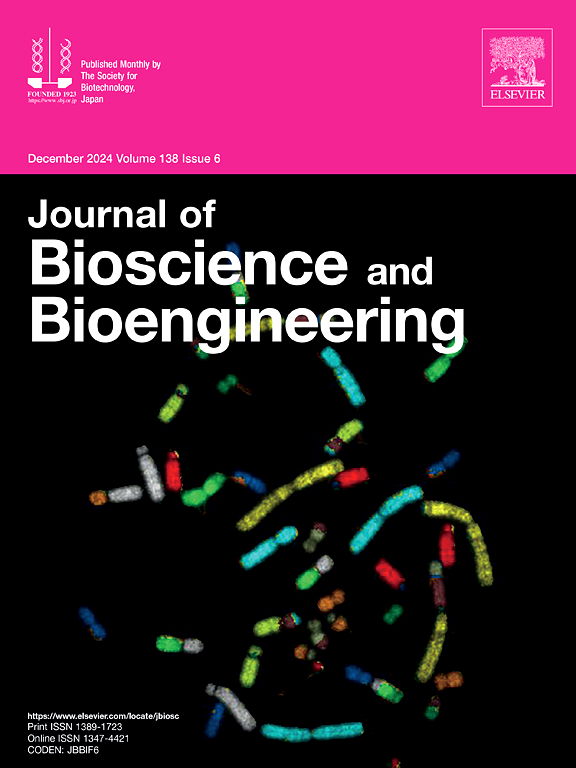Acetate-mediated two-stage microbial production of poly[(R)-3-hydroxybutyrate] (PHB) from CO2 and H2 using a synthetic medium free of vitamins and cysteine
IF 2.9
4区 生物学
Q3 BIOTECHNOLOGY & APPLIED MICROBIOLOGY
引用次数: 0
Abstract
The objective of this study is to use the thermophilic acetogen Thermoanaerobacter kivui and a vitamin- and cysteine-free synthetic medium for an acetate-mediated two-stage microbial production of the biodegradable polymer poly[(R)-3-hydroxybutyrate] (PHB) from CO2 and H2. In the first stage, T. kivui could produce 10 g/L acetate within 14 days during anaerobic chemoautotrophic culture with substrate gas (H2:CO2 = 80:20) using cysteine-free DSMZ 171 medium (originally vitamin-free) in the presence of the pH neutralizer CaCO3. In the second stage, the acetate-containing spent medium obtained from the vitamin- and cysteine-free chemoautotrophic culture of T. kivui could be used for the aerobic culture of Cupriavidus necator for PHB production. Specifically, C. necator consumed all of the 5 g/L acetate in the spent medium of T. kivui for 36 h. The cell concentration of C. necator reached 1.2 g/L after 30 h of culture. The PHB content of C. necator reached 38 % (=0.46 g-PHB/L). The PHB yield was 0.11 g-PHB/g-acetate used. The present study can contribute to a sustainable production of bioplastic PHB from CO2 and H2 without vitamins and amino acids and without the risk of flammability problems caused by combustible gases (mixture of H2, O2, CO2).
在不含维生素和半胱氨酸的合成培养基上,醋酸盐介导的两阶段微生物从CO2和H2合成聚[(R)-3-羟基丁酸盐](PHB)。
本研究的目的是利用嗜热厌氧菌kivui和一种不含维生素和半胱氨酸的合成培养基,用醋酸盐介导的两阶段微生物从CO2和H2中生产可生物降解的聚合物聚[(R)-3-羟基丁酸酯](PHB)。在第一阶段,T. kivui在无半胱氨酸的DSMZ 171培养基(最初不含维生素)和pH中和剂CaCO3的存在下,以底物气体(H2:CO2 = 80:20)进行厌氧化学自养培养,在14天内可产生10 g/L的乙酸。在第二阶段,从不含维生素和半胱氨酸的T. kivui化学自养培养中获得的含乙酸酯的废培养基可用于产PHB的赤铜(Cupriavidus necator)有氧培养。其中,C. necator在36 h内消耗掉了T. kivui废培养基中5 g/L的乙酸,培养30 h后,C. necator的细胞浓度达到1.2 g/L。C. necator的PHB含量达到38% (=0.46 g-PHB/L)。PHB产率为0.11 g-PHB/g-乙酸酯。目前的研究有助于从CO2和H2中可持续地生产生物塑料PHB,而不需要维生素和氨基酸,并且没有可燃气体(H2, O2, CO2的混合物)引起的可燃性问题的风险。
本文章由计算机程序翻译,如有差异,请以英文原文为准。
求助全文
约1分钟内获得全文
求助全文
来源期刊

Journal of bioscience and bioengineering
生物-生物工程与应用微生物
CiteScore
5.90
自引率
3.60%
发文量
144
审稿时长
51 days
期刊介绍:
The Journal of Bioscience and Bioengineering is a research journal publishing original full-length research papers, reviews, and Letters to the Editor. The Journal is devoted to the advancement and dissemination of knowledge concerning fermentation technology, biochemical engineering, food technology and microbiology.
 求助内容:
求助内容: 应助结果提醒方式:
应助结果提醒方式:


